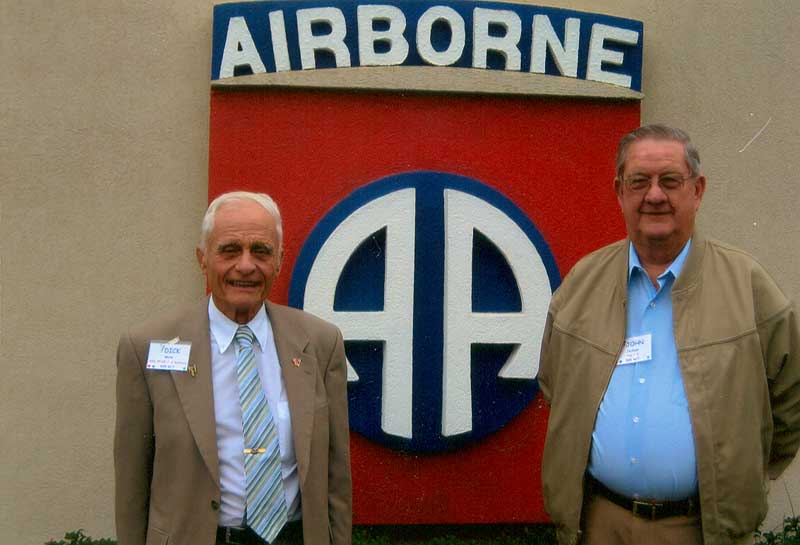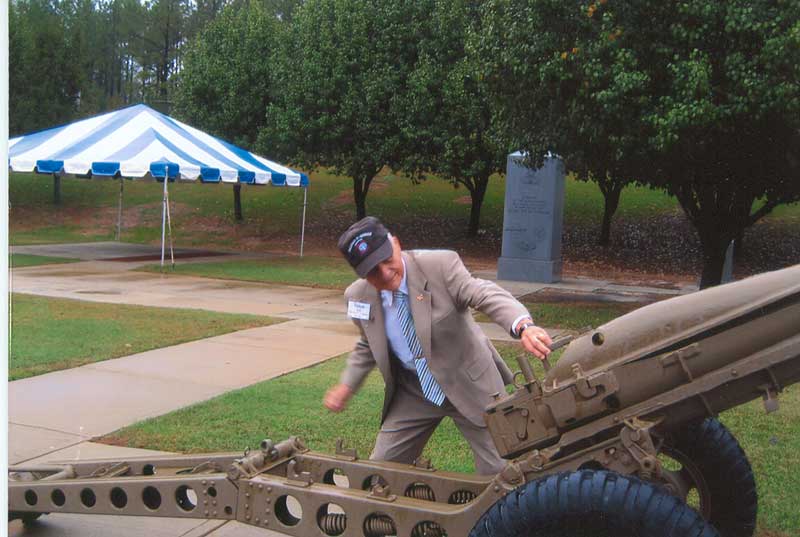
|
Broad Ripple Random Ripplings

The news from Broad Ripple
Brought to you by The Broad Ripple Gazette
(Delivering the news since 2004, every two weeks)

|
| Brought to you by: |

|

|

|

|

|

|
Converted from paper version of the Broad Ripple Gazette (v06n01)
A local soldier's biography - Mote - By Mario Morone
posted: Jan. 09, 2009
Indianapolis native (and south Broad Ripple resident) Richard Mote was drafted into the U.S. Army in July of 1943 shortly after graduating from Tech High School. He took basic artillery training at Fort Bragg, North Carolina. In January of 1944, he was sent overseas to Cardiff, Wales. He joined the 82nd Airborne in February of 1944, becoming a gun mechanic, maintaining a 75 mm pack Howitzer. He recently shared his story in the service with me.
Mote demonstrates loading a 75 mm Howitzer.

image courtesy of Richard Mote
"I was a 20 year-old Sgt-T gun mechanic for A Battery, 456 Field Artillery Battalion, 505th Parachute Infantry Regiment, 82nd Airborne Division during the Belgian Ardennes Campaign that became known as the 'Battle of the Bulge.' On a very cold day in early January of 1945, six guns from our battery were ordered to be moved to a new location where we were to set near a crossroads in this long valley surrounded by the Ardennes Mountains. It was barely wide enough for a horse drawn farm vehicle, let alone our towed 75 mm Howitzers being pulled by big Army trucks. Plus the fact the ever present ground cover of snow was quite deep in places. We inched our way slowly along this path that had a small stream trickling under a blanket of ice on one side and dense snow-covered hedgerows lining the other side. It was an interesting experience just getting to our new area and setting up. I recall thinking how beautiful of a pastoral winter scene this was if one could forget for a moment we were in a war," Mote recalled.
"After digging in the guns as much as the frozen earth would allow, we took a well earned rest in late afternoon. A couple of buddies and I nosed around the area and we found a kind of plastered log hut about the size of a one-car garage. It was located close enough to the guns that the three of us figured we'd found the perfect place to stay for the night. Once inside the small hut, much to our dismay, we discovered the hut must have taken a hit as its log roof ceiling was aglow with brightly smoldering embers. We looked at each other and shrugged our shoulders. It was extremely cold outside, just a few degrees above zero. We decided to take the chance the roof wouldn't cave in. It was the warmest night I spent in the Ardennes Mountains, sleeping under the most unusual fireplace I'd ever seen. That "embering" roof smoldered all night, but never did fall in," Mote noted.
"Before staying that night in the hut, I did some personal exploring. I ran across the body of a dead German solider that our burial unit had not picked up yet. He was lying in a ditch, frozen solid with his left arm thrust straight up in the air. In the fading sunlight, I noticed a gold wedding band on his ring finger. I had some sad thoughts thinking about him having been married even though I was single at the time," he said.
"Before nightfall, I decided to do some foraging to see if there was anything I could liberate. Seeing a footpath between the hedgerows, I climbed up through up through it. On the other side of the hedgerow was appeared to be another German soldier's body that was frozen stiff. I started to turn and leave, but something compelled me to take a closer look. He was just a kid who couldn't have been more than 14 or 15 years old. He was smooth-faced with no hint of whisker stubble. His arms were halfway folded across his chest. He was clutching a Vulgate (a Roman Catholic Bible) that had a very pretty Rosary wrapped around it. As I backed away, it hit me: 'This young German boy worshiped the same creator as I did!' That scene really brought home to me the true horror of war," he stated.
Richard Mote & fellow soldiers prepare to march in a parade.

image courtesy of Richard Mote
"When I returned to the battery, about 20 of our troops trudged into the command post wanting to know if we had anything to eat we could spare them. They were hollow-eyed, unshaven and dirty beyond belief. Their uniforms were faded and ripped. You could see the war etched on their faces. When the group passed by me, I asked a fellow what company they were with where they'd come from. In a lifeless monotone voice, he answered, 'Eighty-second Airborne.' That was a day I'll never forget," he recalled.
"During service, while in Holland, I met a Dutch teenager named Henk Van Der Velden. We have in stayed contact through the years, visiting with and writing to each other," he mentioned.
Mote was discharged from the U.S. Army in December 30, 1945. He married the former Joyce Lutes on August 16, 1952. They have three children and eight grand-children. Attending college on the G.I. Bill, he graduated from Crittenden College with a B.A. in history and from Butler University with an M.A. in history. He taught social studies to junior high students in the Indianapolis Public Schools for 37 years before retiring in June of 1987.
Richard Mote returned to a liberated Paris in 1999.

image courtesy of Richard Mote
Mote's late brother, James, was a chaplain's assistant who earned a bronze star for bravery in the Battle of the Bulge, serving in the U.S. Army's 84th Infantry Division. His sister, Phyllis, is retired and lives in Florida.
Mote frequently swims at the Riviera Club and has participated in tandem sky-diving since 1997. Another hobby he enjoys is making wine.
He has attended numerous military reunions and has made many return visits to Europe. He discusses his years in the service to various schools groups. Mote took three of his granddaughters to the 60th Anniversary of D-Day observed in June of 2004. They also visited Belgium, England, France, Germany and the Netherlands.
Hoosier native Richard Mote and countless fellow veterans give Americans many reasons to be thankful for their freedom not only during the holidays, but every day of the year.

image courtesy of Richard Mote

image courtesy of Richard Mote
mario@broadripplegazette.com

|

|

|
| Brought to you by: |

|

|

|
| Brought to you by: |

|

|

|


